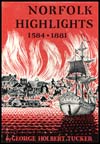Chapter 28
Flags of Fortune
The painted recognition flags on the sides of a fragile Liverpool pitcher, now owned by Barton Myers III of Toronto, Canada, preserve one of the most interesting records of Norfolk's late Eighteenth and Early Nineteenth Century commercial prosperity.
Recognition flags were oblong or pennant-shaped pieces of bunting on which the color code or the symbol of the merchant who owned the vessel were displayed. Since the pitcher bears the initials "T.W.," and since Thomas Willock's bunting is among those depicted, it is reasonable to assume that it originally belonged to him. Somewhere along the line, however, the pitcher came into the possession of Moses Myers, another prominent Norfolk merchant of that era. And its present owner is one of his direct descendents.
The pitcher dates from the late Eighteenth or early Nineteenth Century period when Norfolk enjoyed a span of tremendous commercial prosperity. With the signing of the Treaty of Paris in 1783, ending the Revolutionary War, foreign merchantmen began to enter the Capes again. And it was not long before Norfolk resumed its place as the chief port of entry and export for Virginia.
All of those whose flags and names appear on the pitcher amassed large fortunes from brisk trade with the West Indies during the Napoleonic Wars. And almost all of them went bankrupt or lost most of their fortunes because of national and economic complications later. But that was all in the future when the pitcher bearing the Norfolk merchant's recognition flags was new. And, in the meantime, prosperity reigned in the countinghouses and warehouses along Norfolk's waterfront.
As a result of the French Revolution, war broke out all over Europe, and as the merchant fleet of Great Britain was too busy conveying military supplies to ports other than the West Indies, the people of those islands were faced with starvation unless vital foodstuffs were imported from the United States.
Since Virginia had those supplies in abundance, the governing bodies of the islands disregarded the Navigation Acts, which forbade the importation of commodities into the British dependencies in other than British bottoms, and welcomed the ships of the Norfolk merchants.
In exchange for grain, flour, beef, pork, lumber, and other supplies, the Norfolk vessels brought back all manner of exotic cargoes, ranging from great logs of Santo Domingo mahogany to puncheons of St. Kitt's rum.
But Norfolk's commercial supremacy of that period was short-lived. President Jefferson's embargo on foreign trade as a retaliatory measure against Great Britain; the War of 1812; the capture of Norfolk vessels by French privateers (the French Spoliation); and the opening of the Erie Canal, which easily gave New York precedence over all of the Atlantic ports -- each contributed to the ruin of Norfolk's once prosperous merchants.
The following observation, taken from the Norfolk Gazette and Public Ledger of January 4, 1815, is sufficient comment on what happened:
"Some years ago walking through Wide Water Street, I was much incommoded by rum puncheons, sugar hogsheads, bales of goods, flour and tobacco hogsheads. I heard the bawling of Negroes as they hoisted these goods in and out of vessels, and I got the odor of tar and turpentine. I was in constant danger of breaking my shins on the skids of passing drays. Recently I again went through Water Street, Market Square, and Main Street. No rum puncheons, no bales of goods, no sugar and tobacco hogsheads, no bawling Negroes, no drays passing. Instead of plodding merchants, and busy clerks, I saw only some military officers, ten or twelve idle youths, a few recruits, and a group of Negroes. From the nearby dram shops came the fumes of egg-nog and cigars, and the sound of fiddles and tamborines."
Chapter
29
Decatur Drinks a Famous Toast
Norfolk Highlights 1584 - 1881

See the "Table of Contents" for links to every chapter in Norfolk Highlights 1584 - 1881 by George Holbert Tucker.
